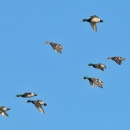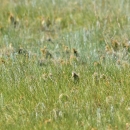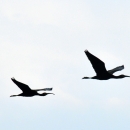About Us
The purpose of Bowdoin National Wildlife Refuge is to preserve and enhance resting, feeding, and breeding habitat for migratory birds and other wildlife. The refuge attracts migrating waterfowl and shorebirds by the thousands and provides breeding and nesting habitat for ducks, geese, grassland songbirds, and colonial nesting water birds. The area is equally important to a variety of resident wildlife, including raptors, pronghorn antelope, sharp-tailed grouse, and coyotes. Many species of state and federal concern can be seen at the refuge during different times of the year, including bald eagles, piping plovers and on occasion peregrine falcons.
North-central Montana is made up of many depressional wetlands created by glaciers over 12,000-15,000 years ago. Geologic history indicates that Lake Bowdoin was once an oxbow of the pre-glacial Missouri River channel. Today, the Missouri River lies nearly 70 miles south of Bowdoin National Wildlife Refuge.
Major habitat types on the refuge include saline and freshwater wetlands, native prairie, planted dense nesting cover and shrubs. The refuge consists of more than 6,000 acres of freshwater and saline wetlands. There are three major wetland types on the refuge: permanent wetlands; semi-permanent wetlands; and seasonal or temporary wetlands. The remaining upland is typical mixed-grass prairie with a complex of western wheatgrass, needle and thread grass, silver sagebrush sagebrush
The western United States’ sagebrush country encompasses over 175 million acres of public and private lands. The sagebrush landscape provides many benefits to our rural economies and communities, and it serves as crucial habitat for a diversity of wildlife, including the iconic greater sage-grouse and over 350 other species.
Learn more about sagebrush , and forbs. The marsh areas are dominated by sedges, while excellent stands of emergent and aquatic vegetation are found in the shallow, open-water areas.
Our Mission
Refuge Purpose
Each unit of the National Wildlife Refuge System is established to serve a statutory purpose that targets the conservation of native species dependent on its lands and waters. All activities on those acres are reviewed for compatibility with this statutory purpose.
Executive Order 7295, February 14, 1936 established Bowdoin National Wildlife Refuge as a refuge and breeding ground for migratory birds and other wildlife. This was later reaffirmed through Executive Order 8592, November 12, 1940.
Our Vision
Under seemingly limitless skies, Bowdoin National Wildlife Refuge provides vast expanses of gently rolling native mixed-grass prairie, dotted with an array of diverse wetlands. Recognized as one of the most important migratory bird refuges in the State of Montana, these habitats are managed to ensure that grassland-and wetland-dependent waterfowl, shorebirds, songbirds, and native wildlife species thrive. Visitors recognize these unique and wondrous qualities and experience a sense of solitude and a connection to the land that fosters a desire to conserve this and other remnants of the northern Great Plains.
Our History
Before becoming a national wildlife refuge national wildlife refuge
A national wildlife refuge is typically a contiguous area of land and water managed by the U.S. Fish and Wildlife Service for the conservation and, where appropriate, restoration of fish, wildlife and plant resources and their habitats for the benefit of present and future generations of Americans.
Learn more about national wildlife refuge , the lands within Bowdoin were managed by the Bureau of Reclamation. Initially this land was reserved from public domain (public land placed into permanent reserved status, such as a national wildlife refuge, that is not held in private ownership).
When President Franklin D. Roosevelt established Bowdoin Migratory Waterfowl Refuge in 1936, the Bureau of Biological Survey (a precursor to the U.S. Fish & Wildlife Service) and Reclamation shared jurisdiction. Lake Bowdoin was managed by Reclamation as a large sump or catch basin for precipitation, runoff events, early spring floods, irrigation return flows, and seepage water from surrounding lands.
After winters of sufficiently heavy snowfall followed by spring runoff, flood waters from Beaver Creek and the Black Coulee drainage would pour into the lake basin, resulting in high water elevations. These spring floods most always coincided with the spring waterfowl migration period. The flooding created conditions exceptionally well suited to waterfowl, both for feeding and selection of nesting sites. The refuge, located in the Central Flyway, an extensively used flight path for large numbers of waterfowl, marsh and shore birds, and where many of which remain to nest in the area. Old time residents around Bowdoin as well as early day naturalists and biologists tell of spring and summer migratory bird concentrations that were no doubt the largest in the state.
After establishment in 1936, an extensive system of dikes, ditches, and water control structures were constructed to better manage the available water supply.
The establishment and early history of the refuge is tied to the Emergency Relief Act and the Works Progress Administration program. Created by President Franklin D. Roosevelt during the Great Depression and the Dust Bowl era of the mid-1930s, these programs were developed to employ the maximum number of people to work on public lands. Most of the early development work completed through the Works Progress Administration program consisted of the construction of dikes, large rubble masonry water control structures, shelterbelts, landscaping, fencing, and building patrol and access roads. In addition, a residence for the manager, headquarters/office, shop, vehicle storage buildings, and an observation tower were also constructed.
In 1937, the agency negotiated a memorandum of agreement with Reclamation to receive part of their water right from the Milk River Project. In return, the agency contributed $40,000 toward construction of the Fresno Reservoir storage facility near Havre, Montana (Water is the lifeline between management and waterfowl survival and is essential to wildlife management at the refuge).
On November 15, 1940, Executive Order 8592 changed the refuge name to Bowdoin National Wildlife Refuge and added additional land.
On March 22, 1971, a revocation of reclamation withdrawal was filed to give primary jurisdiction to the Service. This revocation was approved on February 7, 1972, under Public Land Order 5162. While under Reclamation jurisdiction, Lake Bowdoin was managed as a sump for irrigation return flows from the Milk River Project.





